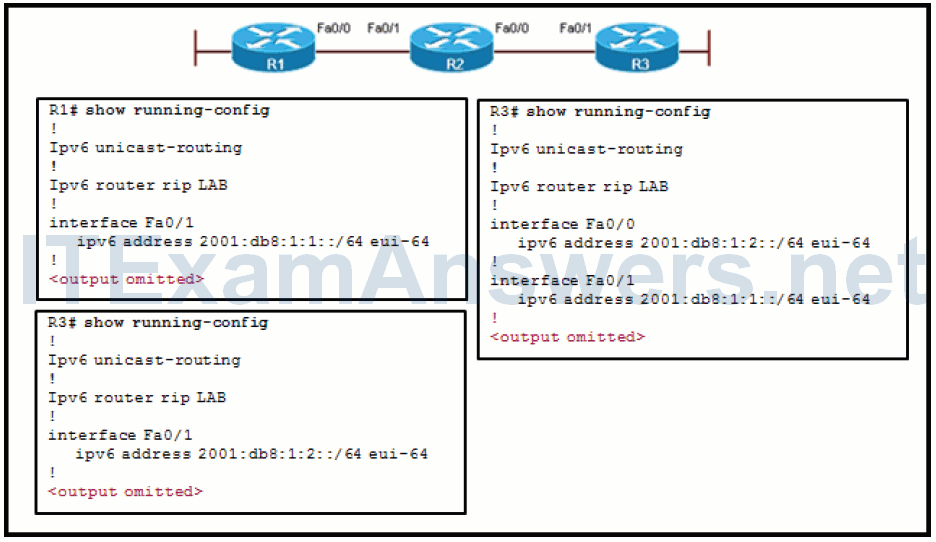1. Which two major areas can be used when discussing the highlevel overview of a typical enterprise network? (Choose two)
- Building distribution
- Building access
- Campus backbone
- Enterprise edge*
- Enterprise campus*
2. Which of the following is used when choosing a dynamic routing protocol? (Choose two.)
- Knowledge level of a specific routing protocol*
- Scalability*
- Type of links supported
- Cost of equipment
- Vendor support
3. BGP is which type of protocol?
- Advanced distance vector
- Linkstate
- Path vector*
- Distance vector
4. Which two factors can influence convergence time for a routing protocol? (Choose two.)
- Fine tuning routing protocol timers*
- Type of link between routers
- Configuring route summarization*
- Size of the routing table
5. Scalability of a network includes which two factors? (Choose two.)
- Number of routers*
- Ability to do auto summarization
- Number of adjacent neighbors*
- Distance between routers
6. Which of the following traffic types is not supported by IPv6?
- Broadcast*
- Multicast
- Anycast
- Unicast
7. What is the IPv6 multicast address used by EIGRP?
- FF02::6
- FF02::5
- FF02::9
- FF02::A*
8. Which type of IPv6 address is used by routing protocols for communications only on the link?
- Linklocal*
- Site local
- Unique local
- Multicast
9. Which type of ICMPv6 message is sent by a device to request information about the network such as the prefix, prefix length and default gateway?
- Router Advertisement
- Router Solicitation*
- Neighbor Solicitation
- Neighbor Advertisement
10. Which type of ICMPv6 message is sent by a device to inform another device of its IPv6 address and associated Ethernet address?
- Neighbor Solicitation
- Router Advertisement
- Router Solicitation
- Neighbor Advertisement*
11. Which type of network allows access to multiple devices on the same network but does not provide broadcast capabilities?
- Multiaccess
- NBMA*
- Broadcast
- Pointtopoint
12. Which type of subinterface provides connections similar to physical pointtopoint links and has no neighbor discovery issues?
- Multipoint
- Pointtomultipoint
- All of the above
- Pointtopoint*
13. Which tunneling protocol was developed by Cisco to encapsulate a Layer 3 protocol inside a pointtopoint, tunneloverIP network?
- MPLS
- DMVPN
- IPsec
- GRE*
14. A Layer 3 MPLS VPN over GRE is an example of what type of VPN?
- DMVPN
- Hybrid VPN*
- MultiVPN
- Combination VPN
15. What is the main benefit of a GRE tunnel in respect to routing protocols?
- Supports IP multicast*
- Stateless
- Strong security
- Low overhead
16. What protocol is used by routers to determine the nexthop IP address in tunneling networks?
- MPLS
- Dynamic GRE
- NHRP*
- mGRE
17. What framework of open standards that provides confidentiality, data integrity, authentication and antireplay protection?
- VPN
- PSK
- IPsec*
- PAP
18. R1 has an adjacent RIPng neighbor R2. R1 has a LAN with no neighbors, 2001:DB8:ACAD:1::/64. R1 advertises this prefix to adjacent RIPng neighbor, R2. What metric does R2 display for 2001:DB8:ACAD:1::/64?
- 2 hops*
- 1 hop
- 4 hops
- 3 hops
19. How is an interface enabled for RIPng?
- Interfaces are automatically enabled for RIPng when the RIPng process is started
- Using the router ripng name interface command
- Using the ipv6 router rip name interface command*
- Using the network prefix/prefixlength router mode command
20. Router R1 has multiple routes in its routing table including RIPng routes, directly connected networks and a static default route. R2 receives a static default route from R1 but no other routers. This is because R1 uses which option at the end of ipv6 rip name default information interface command?
- defaultonly
- static
- only*
- originate
21. Refer to the exhibit. RIPng has been configured on all routers in the network but the routers do not receive RIP routing updates. What could be done to remedy the problem?
- Issue the command ipv6 rip LAB enable for the interfaces that are participating in the routing process.*
- Configure the network statement under the routing protocol configuration.
- Configure the RIPng version 2 under the routing protocol configuration.
- Configure IPv4 addresses for the interfaces that are participating in the routing process.
Download PDF File below:
